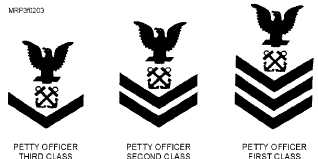ownership markings. Markings shall be a stencil
consisting of owner’s surname and last four digits of
owner’s social security number placed inside the
garment as outlined in Uniform Regulations. Stencil
letters shall be approximately l/2-inch high and
blocked. Markings shall be black on white uniforms,
and white on blue uniforms. Blue chambray/utility
shirts shall be marked in black. Blue working jackets
and dungaree/utility trousers shall be marked in white.
Embroidered letters on chambray/utility shirts,
dungarees/utility trousers, and blue working jackets
shall be approximately l/2-inch high and blocked.
Embroidered letters on camouflage uniforms and
Navy coveralls shall be approximately 3/4-inch high
and blocked. Name tape shall match color and fabric of
the uniform component and shall be the length of the
width of the pocket. Blue chambray/utility shirts shall
be embroidered in black. Blue working jackets and
dungaree/utility trousers shall be embroidered in
white. Coveralls shall be embroidered in silver for E-6
and below. There are many other uniform
requirements. Therefore, Uniform Regulations must
be reviewed for current information.
When charged with holding sea-bag inspections
consult local instructions for prescribed procedures.
The petty officer assigned to hold sea-bag inspections
could use the following as a guide for the inspection:
Prescribe a time and a place to hold the
inspection. Remember the sea bag contains
many items, so room for the items to be laid out
will be needed.
Have a current list of all required items along
with a copy of the stencil marking section from
the Uniform Regulations.
Instruct the person to present each item as you
call it off the list, or the person can present an
item and you can mark it off the list. Remember
to check the quantity of each item.
Check the clothing for required stenciling and
other required markings.
When the inspection is complete, have the
person sign the inspection list to acknowledge
items missing, needing replacement, or
maintenance.
PETTY OFFICER’S INSIGNIA
As a petty officer, you should set an example for
subordinates both in conduct and in appearance. An
important part of your appearance is the manner in
which you wear your uniform and insignia. The term
insignia includes cloth rating badges, which are worn
on the left sleeve of your uniform, collar insignia, and
insignia worn on military headgear.
Rating Badges
Rating badges for petty officers differ according to
paygrade, specialty, size, and color. They consist of a
perched eagle with extended wings pointing upward
and its head facing right. As shown in figure 2-3,
chevrons, indicating the wearer’s rate, and a specialty
mark, indicating the wearer’s rating, make up the
badge. Rating badges worn on blue working jackets
and chambray shirts have no specialty mark.
Chambray iron-on or sew-on rating badges are
permitted on chambray shirts. Chevrons on rating
badges for men, E-4 through E-6, measure 3 1/4 inches
wide. Chevrons on women’s rating badges measure
2 1/2 inches wide and their rating insignia are three
fourths of the size of men’s insignia. The men’s size
rating badge is worn on the pea coat whether the pea
coat is worn by a man or a woman.
Standard navy blue rating badges have
embroidered backgrounds and are worn on navy blue
uniforms. You may wear navy blue badges mounted on
fabric which matches the fabric color and cleaning
characteristics of the uniform on which it is worn.
Rating badges with white backgrounds match the
fabric of uniforms on which they are worn. Colors of
the eagle, specialty mark, chevrons, and service stripes
for prescribed uniforms and components are described
in table 2-1.
2-9
Figure 2-3. E-4, E-5, and E-6 rating badges.

